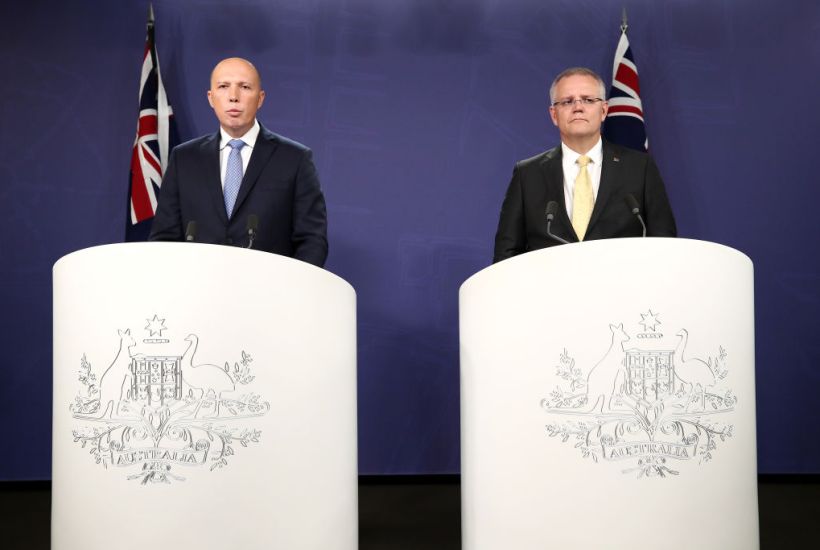Malcolm Turnbull did not lead a ‘Labor-lite’ government. He led a Liberal government for the twenty-first century.
I almost choked on my Weetbix when I read Simon Benson’s genius insight mid-October; “Morrison’s electoral salvage operation is starting to produce results. Coalition voters believe he is a better bet against Shorten than Turnbull”. With Turnbull’s 49-51 two-party-preferred having plunged to 45-55 under Scott Morrison’s new leadership, Benson’s assessment necessitated deeper inspection.
The removal of Malcolm Turnbull as prime minister marked a quintessential moment in the Liberal Party’s search for meaning. Australia’s most successful political party is facing a moment of crisis as it confronts the two essential political questions: who are the Australian people and how can Liberal values be electorally successful within that reality?
This search has occurred in a battle between reactionaries and liberal moderates over the best means to bring Robert Menzies’s founding vision into the current-day.
Like Islamic Salafists, who refuse contextual adaptation for the sake of Muhammed’s initial teachings, reactionaries sternly resist change to the national consensus of Menzies’ heyday. Imbued by the spirit of society in the 1950s, reactionaries want to frustrate the new Australian reality.
In contrast, liberal moderates acknowledge shifting social norms and expectations, and seek to apply the core Liberal principles to that reality. They respect the scientific impetus for action on climate change, acknowledge redefined social norms reflected in same sex marriage and recognise that among an increasingly agnostic demographic, discrimination is seen a greater misdeed than impeded religious freedom.
A common misconception is that reactionaries are conservatism’s last vanguard within an altogether different Liberal Party. This is untrue.
Conservatism differs from reactionary liberalism in that it is not a political doctrine, but a system of logic when considering policy change. Where reactionaries are particular in pursuing 1950s Australia, conservatism is adaptive to any political ideology. For instance, conservative Labor members can pursue the party’s leftist economic message while pressing the importance of our connection to the British monarchy.
Liberal moderates are also often conservatives.
Malcolm Turnbull was a true liberal who listened and responded to the demands of the people. He did not support change for change’s sake nor work to impose a particular reality, as is the philosophy of the interventionist Labor Party.
On same sex marriage he said; “Has life as we know it ground to a halt, has traditional marriage been undermined… the answer is plainly no”. Therein lies the truth to liberal conservatism. Having observed that gay marriage offered no threat to the institution of marriage and having accepted the new national consensus that favoured a changed definition, there was no reason to resist the process.
Yet, not even a plebiscite that delivered 62 per cent support for same-sex marriage was enough to convince reactionaries Tony Abbott and Eric Abetz of a new national consensus.
Gay people “are good people… but that doesn’t mean that we can’t continue to reserve the term ‘marriage’ for the relationship of one man with one woman”, wrote Abbott. Hardly an accurate reflection on public sentiment.
“Most people in a democracy believe social policy should be determined by the people”, Abetz wrote in 2015. However, when the public instructed change to the definition of marriage, Abetz said “it would be up to each member to decide whether… it is good or bad public policy”.
This is the challenge reaction presents to the Liberal Party’s very viability in the twenty-first century. Reactionaries turn a blind eye to new expectations and electoral realities in the hope they can continue to institute an outdated liberal doctrine.
In the twenty-first century, we confront a new demographic reality. The property-owning nucleus of Menzies’ is giving way to a renting class. Analysis of the Victorian election has shown that in John Pesutto’s seat of Hawthorn, he won easily in the Kooyong and Hartwell booths as places dominated by family homes. Yet, at the Glenferrie booth, which sits near the train line and university, he was slaughtered with a two-party-preferred vote of just 36 per cent.
A Liberal platform founded in the weatherboard and brick veneer reality of Menzies cannot hope for success when many are now locked out of the property market and feel disconnected from the old language of the middle-class family unit.
Victorian voters turned up their noses at Mathew Guy’s reactionary racial dog whistling. We are no longer a nation easily at fear of foreign nationals or cultural diversity. Endless sloganeering on ‘African gangs’ and cultural security offered no match for Daniel Andrews undeniable record of infrastructure delivery.
Reactionaries miss the mark on many fronts. Australians are by no means raving feminists, but they certainly accept a woman’s equal entitlement to the workplace. Where Abbott would have “the housewives of Australia… understand as they do the ironing”, Turnbull initiated the ‘disrespect is where all violence against women starts’ campaign. The Liberal Party has traditionally drawn disproportionate support from women who were unfit for Labor’s male-dominated union culture.
It is easy to see that moderates offer better prospect to continued support from the female demographic.
So, what unites liberal moderates and reactionaries? Why do they sit in the Liberal party together? There is truth to the timeless classic that there is more to unite, than divide.
The Liberal Party retains the values essential to a prosperous Australia. Its core faith in the independence and initiative of the individual, in the unimpeded creativity of free enterprise and free markets – its liberal fundamentals – and a conservative approach to change for the sake of change, still offers the best solution to the challenges of the twenty-first century.
In the age of the innovator, where unprecedented Chinese investment in tech industry has propelled its economy towards the world’s largest, the Liberal entrepreneur-impetus remains ever relevant.
Turnbull’s ‘Landing Pads’ program sought to enhance this process by enabling Australian start-ups to bring their ideas to a global market, thereby generating employment and economic growth for Australians back home.
There should be a measured alternative to the political correctness and identity politics dominating the Labor Party and infiltrating our universities. Turnbull presented a rational advocate for the preservation of our January 26 national holiday. He also displayed his conservative credentials in resisting Shorten’s premature lunge towards an Australian republic. He noted strong public satisfaction with Queen Elizabeth’s rule and insisted “there is no point pretending that there is an appetite for change where there isn’t one at the moment,” he said.
However, reactionaries would have you believe Malcolm Turnbull led a ‘Labor-lite’ government – an insurgent seeking to reconfigure the party in Labor’s image.
This absurd reactionary thesis neglects that Turnbull ultimately achieved more in the name of Liberalism than their champion Tony Abbott.
It was Prime Minister Malcolm Turnbull who cut the company and personal tax rate, delivered a National Innovation Agenda, did-away with incongruous school funding for a sustainable national model, defended the rule of law by reinstituting the ABCC, brought the budget to its strongest position since the Howard-era, and pursued a technology-agnostic energy platform that would secure lower power prices ahead of irrational renewable obsession.
This policy achievement was in spite of a concerted reactionary campaign to bring down the government, frustrate the policy process and depict Turnbull as captured and ineffectual.
It is ludicrous to deny Turnbull’s National Energy Guarantee had near universal support in the party and throughout the business community. Only when reactionaries refused to accept the position of the majority did it fail to pass through parliament.
Perhaps the most absurd reactionary view to the Liberal doctrine was in the Monash Forum’s call for a new socialised power station. Idealising coal in a national environment where there was neither sufficient public support nor any potential economic prospect for the project was hopelessly trivial.
Turnbull, equally committed to a reduction in power prices and better reliability, instead pursued Snowy Hydro 2.0. The scheme adds 2,000 MW of new generation capacity and was flagged by the Snowy Hydro board as a “strong economic investment”. In accompanying this benefit to reliability and affordability with renewable technology, Turnbull skilfully balanced the Liberal economic impetus with popular environmental expectations.
While continuing to insist Turnbull’s removal essential to a recapturing of ‘the base’, reactionaries must at some point ask themselves why the promised upsurge in support has been replaced by its total collapse.
Even in the blue-ribbon seat of Kooyong, Treasurer Josh Frydenberg is facing a 15 per cent fall in two party-preferred support and a forecast loss. If there was ever to be a place to assess the Liberal heartland, it is there.
The Party must do away with the perception that it is dominated by climate-change deniers, opponents to same-sex marriage and an anti-woman culture.
The time has come for reactionaries to accept greater flexibility. The true battle lies in liberalism over socialism, not conservatism over progressivism. Only when the enduring importance of freedom and the individual is applied to the expectations of the twenty-first century can the Liberal Party look to electoral success.
Tom Akhurst is a member of the Melbourne University Liberal Club.
Got something to add? Join the discussion and comment below.
Got something to add? Join the discussion and comment below.
Get 10 issues for just $10
Subscribe to The Spectator Australia today for the next 10 magazine issues, plus full online access, for just $10.


























Comments
Don't miss out
Join the conversation with other Spectator Australia readers. Subscribe to leave a comment.
SUBSCRIBEAlready a subscriber? Log in